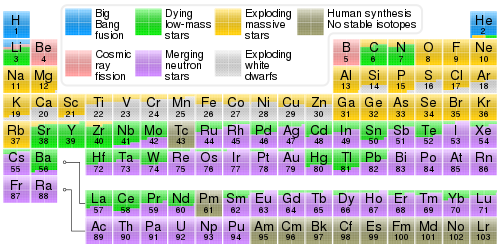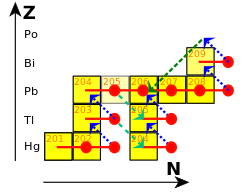s-process
The slow neutron-capture process, or s-process, is a series of
In the s-process, a
A range of elements and isotopes can be produced by the s-process, because of the intervention of alpha decay steps along the reaction chain. The relative abundances of elements and isotopes produced depends on the source of the neutrons and how their flux changes over time. Each branch of the s-process reaction chain eventually terminates at a cycle involving lead, bismuth, and polonium.
The s-process contrasts with the
History
The s-process was seen to be needed from the relative abundances of isotopes of heavy elements and from a newly published table of abundances by Hans Suess and Harold Urey in 1956.[1] Among other things, these data showed abundance peaks for strontium, barium, and lead, which, according to quantum mechanics and the nuclear shell model, are particularly stable nuclei, much like the noble gases are chemically inert. This implied that some abundant nuclei must be created by slow neutron capture, and it was only a matter of determining how other nuclei could be accounted for by such a process. A table apportioning the heavy isotopes between s-process and r-process was published in the famous B2FH review paper in 1957.[2] There it was also argued that the s-process occurs in red giant stars. In a particularly illustrative case, the element technetium, whose longest half-life is 4.2 million years, had been discovered in s-, M-, and N-type stars in 1952[3][4] by Paul W. Merrill.[5][6] Since these stars were thought to be billions of years old, the presence of technetium in their outer atmospheres was taken as evidence of its recent creation there, probably unconnected with the nuclear fusion in the deep interior of the star that provides its power.

A calculable model for creating the heavy isotopes from iron seed nuclei in a time-dependent manner was not provided until 1961.
The s-process in stars
The s-process is believed to occur mostly in asymptotic giant branch stars, seeded by iron nuclei left by a supernova during a previous generation of stars. In contrast to the r-process which is believed to occur over time scales of seconds in explosive environments, the s-process is believed to occur over time scales of thousands of years, passing decades between neutron captures. The extent to which the s-process moves up the elements in the chart of isotopes to higher mass numbers is essentially determined by the degree to which the star in question is able to produce neutrons. The quantitative yield is also proportional to the amount of iron in the star's initial abundance distribution. Iron is the "starting material" (or seed) for this neutron capture-beta minus decay sequence of synthesizing new elements.[citation needed]
The main neutron source reactions are:

One distinguishes the main and the weak s-process component. The main component produces heavy elements beyond
The s-process is sometimes approximated over a small mass region using the so-called "local approximation", by which the ratio of abundances is inversely proportional to the ratio of neutron-capture cross-sections for nearby isotopes on the s-process path. This approximation is – as the name indicates – only valid locally, meaning for isotopes of nearby mass numbers, but it is invalid at magic numbers where the ledge-precipice structure dominates.

Because of the relatively low neutron fluxes expected to occur during the s-process (on the order of 105 to 1011 neutrons per cm2 per second), this process does not have the ability to produce any of the heavy radioactive isotopes such as thorium or uranium. The cycle that terminates the s-process is:
:
by β− decay, restarting the cycle:
The net result of this cycle therefore is that 4 neutrons are converted into one alpha particle, two electrons, two anti-electron neutrinos and gamma radiation:
The process thus terminates in bismuth, the heaviest "stable" element, and polonium, the first non-primordial element after bismuth. Bismuth is actually slightly radioactive, but with a half-life so long—a billion times the present age of the universe—that it is effectively stable over the lifetime of any existing star.
The s-process measured in stardust
Stardust is one component of
References
- .
- ^ Burbidge, E. M.; Burbidge, G. R.; Fowler, W. A.; Hoyle, F. (1957). "Synthesis of the Elements in Stars". .
- ^
Hammond, C. R. (2004). "The Elements". Handbook of Chemistry and Physics (81st ed.). ISBN 978-0-8493-0485-9.
- ^
Moore, C. E. (1951). "Technetium in the Sun". PMID 17782983.
- ^ Merrill, P. W. (1952). "Technetium in the stars". Science. 115 (2992): 484.
- ^ George Sivulka (8 March 2017). "An Introduction to the Evidence for Stellar Nucleosynthesis". Stanford University. Retrieved 3 May 2018.
- ^ Clayton, D. D.; Fowler, W. A.; Hull, T. E.; Zimmerman, B. A. (1961). "Neutron capture chains in heavy element synthesis". .
- ^
Clayton, D. D.; Rassbach, M. E. (1967). "Termination of the s-process". doi:10.1086/149128.
- ^
Clayton, D. D. (1968). "Distribution of neutron-source strengths for the s-process". In Arnett, W. D.; Hansen, C. J.; Truran, J. W.; Cameron, A. G. W. (eds.). Nucleosynthesis. Gordon and Breach. pp. 225–240.
- ^
Peters, J. G.; Fowler, W. A.; Clayton, D. D. (1972). "Weak s-process Irradiations". doi:10.1086/151450.
- ^
Clayton, D. D.; Newman, M. J. (1974). "s-process Studies: Exact Solution to a Chain Having Two Distinct Cross-Section Values". doi:10.1086/153082.
- ^
Clayton, D. D.; Ward, R. A. (1974). "s-process Studies: Exact Evaluation of an Exponential Distribution of Exposures". doi:10.1086/153175.
- ^
Ward, R. A.; Newman, M. J.; Clayton, D. D. (1976). "s-process Studies: Branching and the Time Scale". doi:10.1086/190373.
- ^ Macklin, R. L.; Gibbons, J. H. (1965). "Neutron Capture Data at Stellar Temperatures". .
- ^
Kaeppeler, F.; Beer, H.; Wisshak, K.; Clayton, D. D.; Macklin, R. L.; Ward, R. A. (1982). "s-process studies in the light of new experimental cross sections". doi:10.1086/160033.
- ^
Boothroyd, A. I. (2006). "Heavy elements in stars". S2CID 116938510.
- ^ Busso, M.; Gallino, R.; Wasserburg, G. J. (1999). "Nucleosynthesis in Asymptotic Giant Branch Stars: Relevance for Galactic Enrichment and Solar System Formation" (PDF). .
- ^
Srinivasan, B.; Anders, E. (1978). "Noble Gases in the Murchison Meteorite: Possible Relics of s-process Nucleosynthesis". S2CID 21175338.
- ^
Clayton, D. D.; Ward, R. A. (1978). "s-process studies: Xenon and krypton isotopic abundances". doi:10.1086/156449.
- ^ a b
Clayton, D. D.; Nittler, L. R. (2004). "Astrophysics with Presolar Stardust" (PDF). S2CID 96456868. Archived from the original(PDF) on 2020-02-19.
